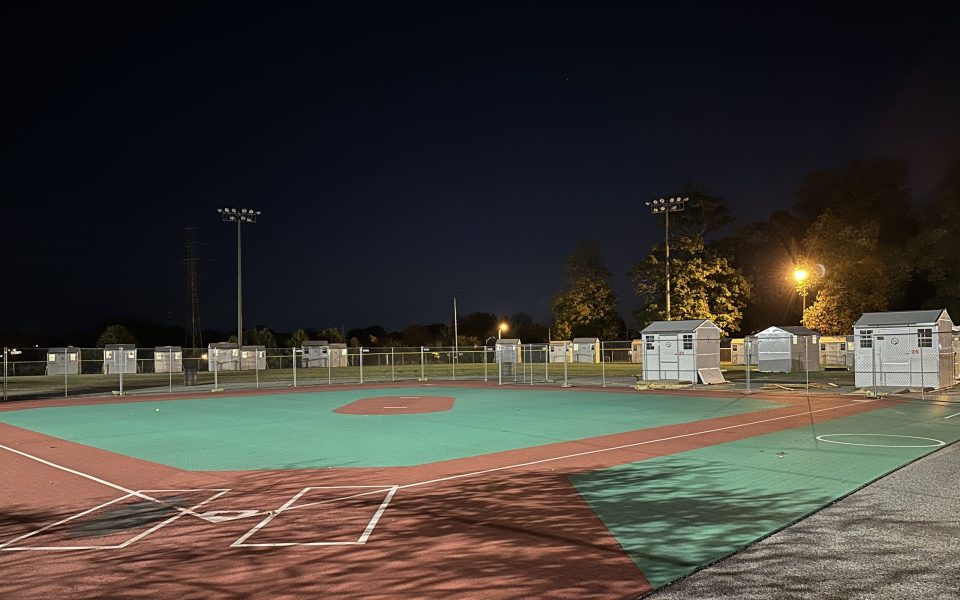Featured photo: Greensboro’s Pallet shelters at Pomona Park in fall 2023 (photo by Gale Melcher).
Greensboro’s second iteration of the Doorway Project comes to an end this week.
The program, which has kept unhoused residents warm using Pallet shelters at Pomona Park for a little more than four months since November 2023, will end on March 20 by 5 p.m when residents move out. The dismantling process is scheduled to be complete by Thursday, March 28.
As of March 8, 95 percent of the shelters are occupied, the city’s Supportive Housing Analyst Elizabeth Alverson told TCB. Twenty-six people have left the program, four of whom were asked to leave “due to disrupting other guests.” Currently, 67 people are on the waitlist.
While 75 people had stayed in the Pallet shelters by the close of March 2023, some city leaders have called it a “Band-Aid” solution. The city’s first year of the program was marked by several issues including problems with onsite showers, access to resources, transportation and IRC staff. However, despite the issues, neighboring Winston-Salem has proposed a similar solution to alleviate homelessness in their communities.
What is life like in the Greensboro Pallet shelters?
In February, TCB spoke to a Pallet resident who requested to remain anonymous. The resident told TCB that they are 64 years old and that they have been homeless for 13 years. Before they moved into their Pallet shelter, they said that they were sleeping on the concrete downtown.
The Doorway Project is a “place to lay your head and stay warm, get you off the concrete,” the resident said.
On Jan. 9, water built up around seven units. Those residents were transported to the IRC for the night out and returned the next day.
While the resident was thankful to have a place to stay during the winter months, they told TCB that they have other ideas for how the city could help people who are unhoused.
“Taking some of these boarded up places and fixing them up for the homeless,” they said.
“If they don’t want us in the park, put us someplace, quit bitching about it. Do something about it.”
Housing
Each Pallet shelter is 64 square feet and can house two people. Residents have little control over who their roommates are, the resident said.
“If they would let us be introduced before they stick us with someone I think it would be a little bit better, because you can know off that bat whether you’re going to get along,” they said.
For safety reasons, residents can’t charge their electronic devices in the Pallet shelters. The resident said that they can charge their phones in the ballpark bathrooms.
The resident has a case worker through the IRC who they meet with once per week, and that staff are helping the “best way they can” to get people housed before they have to move out.
“But I doubt I’ll have any kind of housing” at the end of the program, the resident told TCB.
“I’ll probably be back out on the streets like a lot of these people will,” they said. “Probably where I’ll be back again if nothing else comes up. It is what it is. We just take each day as it comes and do what we can, that’s all we can do.”
At the end of last year’s program, IRC Director Kristina Singleton told TCB that 80 percent of the residents were able to “move into some other type of shelter or housing by the end of the program.”
Transportation
The baseball field is located right across from a city bus stop. This year, each resident has been given an unlimited ride pass, the resident said. That’s a big change from last year. According to Singleton, last year’s residents were given “six bus passes per day allowing guests transportation to any of the food resources of their choice.” However, multiple residents who spoke to TCB last year said that they only received four passes per day — enough to make two round-trip rides.
Food
Last year, there was a microwave on site for part of the program. This year, there’s no microwave, the resident said. However, they noted that several churches bring residents food during the week.
How much does the program cost?
In the last two years, hundreds of thousands of dollars have been funneled into the program. The 30 shelters cost more than $500,000 altogether. The Interactive Resource Center, a drop-in center for the unhoused on Washington Street, is the only organization who applied to run the Doorway Project, both years.
The city’s Housing and Neighborhood Development Director Michelle Kennedy told the city council in November 2022 that the IRC’s $200,000 contract would cover the cost of new staff, food, bus passes, and security costs.
The IRC’s 2022-23 proposal for the program revealed that IRC Director Kristina Singleton requested $200,000 for the program, including $110,000 for food for shelter residents. But TCB’s reporting revealed that food was not provided to residents. The IRC’s 2023-24 proposal did not include a funding request for food.
The IRC followed a reimbursement model with the city according to a March 7, 2023 email from Singleton.
Singleton also requested $56,850 to cover employees’ salaries during the first year, and $61,560 during the second year. The IRC’s cost estimates for their proposal this year varies greatly from last year; for example, last year Singleton estimated that security would cost $19,800. This year, she estimated $90,000. In total, the program is projected to cost $193,660 this year.
What are other cities doing?
Despite some shortcomings with Greensboro’s Pallet program, unhoused residents in other cities have looked to the shelters as a temporary solution.
In early February, unhoused residents and activists organized a sleep-in on the steps of Winston-Salem’s city hall. One unhoused resident named Smiley, who has been on the street for eight years, has lived in cities like Charlotte, High Point and Greensboro. Those cities “do more for us homeless than Winston-Salem does,” he said. Residents like Smiley wish that the city would “take a page out of [Greensboro’s] book.”
In 2023, 520 unhoused people received street outreach services and 1,455 stayed in emergency shelters. The numbers have been trending upward for the last five years.
On March 18, Winston-Salem’s Mayor Allen Joines and councilmembers met for a “committee of the whole” meeting at Union Station near Winston-Salem State University.
“Do we have any clues as to why it’s trending up for homelessness right now?” Councilmember Annette Scippio asked the city’s Home Program Manager Shereka Floyd.
“The lack of housing,” Floyd responded. “We have funds for rental assistance, we have housing choice vouchers, but there’s nowhere to spend those funds and nowhere to use those vouchers if the units are not affordable.”
Floyd explained that the city is looking into purchasing temporary housing like the ones used by Greensboro: 10-15 microshelters created by Foldum Corp. These collapsible structures start at $10,000 with add-ons such as bathrooms and mini-kitchens available for purchase. Units start at 156 square feet — about twice the size of the Greensboro Pallet shelters — and Winston-Salem is looking into designs that can house two people with a wall separating their rooms for privacy.

Mayor Pro Tempore Denise D. Adams said that the city needs to “get out of the box” when it comes to supportive housing and permanent supportive housing.
“What is it that people need right now where they are?” she asked. It’s not always going to be a “brick and mortar building,” she said.
Many of the city’s homeless live in the estimated 270 encampments around the city due to limited shelter space. Councilmember Robert C. Clark said that people often call him saying, “Why don’t you shut down the encampments?” Clark said his response is, “Where do you want them to go?”
All CityBeat reporting content is made possible by a grant from the NC Local News Lab Fund, available to republish for free by any news outlet who cares to use it. Learn More ↗
Republish this storyJoin the First Amendment Society, a membership that goes directly to funding TCB‘s newsroom.
We believe that reporting can save the world.
The TCB First Amendment Society recognizes the vital role of a free, unfettered press with a bundling of local experiences designed to build community, and unique engagements with our newsroom that will help you understand, and shape, local journalism’s critical role in uplifting the people in our cities.
All revenue goes directly into the newsroom as reporters’ salaries and freelance commissions.


Leave a Reply